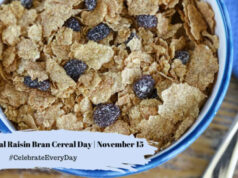
Moooove over whiners! June 4 is National Cheese Day!
- Cheese is produced from the pressed curds of milk. The milk can come from cows, buffalo, goats or sheep. Temperature and aging affect the flavor and texture of the cheese as well as spices and other seasonings added during the process.
- Cheese was created over 4,000 years ago-by accident. Amazingly, one of our favorite foods might never have been discovered if it weren’t for a mistake. Legend has it the first cheese was created accidentally, by storing milk in a container lined with an animal’s stomach. An enzyme from the stomach caused the milk to separate into liquid (whey) and solids (curd). The curd? That’s cheese.
- It takes 10 pounds of milk to make just 1 pound of cheese.
- Over 25% of cheese in the U.S. is made in Wisconsin (the rest comes mostly from California, Idaho and New York). More than half the nation’s artisan cheese is made in Wisconsin.
- Storing cheese in caves, whether natural or man-made, helps to age them and imparts another level of flavor. Caves are cool and humid, which is exactly what cheese needs to age properly.
- Despite popular belief, mice actually don’t like cheese.
- There are 60 Master Cheesemakers in the United States…and every one of them lives in Wisconsin.
- Italy’s Credem Bank takes Parmesan cheese from local producers in exchange for cheap loans (charging 3-5% interest, depending on quality) & a fee ensuring the cheese matures properly (2 yrs) in the bank vault (cheese is sold if the loan defaults). Around 430,000 parmesan wheels ($200M+) are stored there. – Source
- When cheese is digested, it breaks down into an opioid. Other opioids you may know about are heroin and morphine. – Source
- Stilton blue cheese is known to frequently cause odd, vivid dreams. – Source
- American Cheese cannot be legally sold as “cheese” in the United States. It must instead be labeled as “cheese product,” “cheese food,” or “American Singles,” since its manufacturing process varies so significantly from that of other cheeses. – Source
- Philadelphia cream cheese is named after a village in upstate New York, not the famous Pennsylvania city. – Source
- Scientists have successfully created cheese using human bacteria collected from toes and belly buttons. – Source
- Gouda accounts for over half of the world’s cheese consumption. – Source
- Moose cheese costs around $420 per pound, since each milking takes two hours, and must be done in complete silence. – Source
- Some scientists believe that regularly eating Roquefort blue cheese helps people live longer. Their study suggested that the cheese helps to improve cardiovascular health and may explain why French women have a longer life expectancy than others.
- A 2005 study found that eating cheese 30 minutes before bed helps you sleep better. Tryptophan, an amino acid in cheese, has been shown to reduce stress and help induce sleep! And cheddar cheese, the study found, can often help you dream of celebrities.
- Cheese wheels exist for a reason: traditional European cheesemakers realized they could roll their wares around instead of trying to carry it all.
- People who love cheese are called turophiles.
- ‘Cheese’ comes from the Latin word ‘caseus’, which has been found to mean ‘to ferment/to sour’.
- Hard cheeses have a longer shelf live than soft cheeses.
- Blue cheese, which has distinctive smells and tastes, have blue veins running through, which is caused by piercing the cheese and its crust with stainless steel needles and copper wires, to allow air into the product.
- Collecting cheese labels is known as ‘tyrosemiophilia’.
- Pizza Hut is the largest cheese-using fast food giant, it uses approximately 300 million pounds of cheese annually, mostly on pizza.
- Cheese production around the globe is more than the combined worldwide production of coffee, tobacco, tea, and cocoa beans.
- U.S. per capita cheese consumption is about 34 pounds per person—that’s more than one full ton of cheese during the average lifetime. The French eat the most cheese, putting away an average of 57 pounds per person a year.
Sources:












